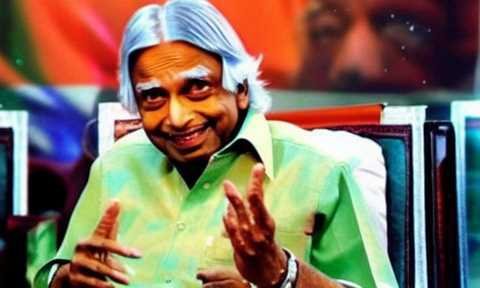APJ Abdul Kalam, a distinguished Indian scientist, was a source of inspiration for millions, particularly youngsters.
He earned the endearing title of “Missile Man of India” and served as India’s 11th President from 2002 to 2007.
Hailing from a small hamlet in Tamil Nadu, Kalam endeavored to diligently achieve his aspirations.
His life’s work was devoted to science and technology, and he played a pivotal role in India’s missile and space programs.
Kalam also authored several books, including “Wings of Fire,” which chronicled his life and accomplishments.
His life and contributions are a beacon of hope and motivation for children in India and beyond.
This essay aims to delve deeper into the life, contributions, and triumphs of this illustrious personality who continues to inspire generations.

10 Liner Essay on APJ Abdul Kalam
1. APJ Abdul Kalam was a great scientist and the 11th President of India.
2. He was born in Rameswaram, Tamil Nadu, and studied Physics and Aerospace Engineering.
3. Kalam made many important contributions to India’s missile and nuclear programs.
4. He was known as the “Missile Man of India” for his work on developing missiles for the country.
5. Kalam was also a writer and authored many books, including his famous autobiography “Wings of Fire.”
6. He was loved by people of all ages for his simple and humble personality.
7. Kalam was a strong believer in education and inspired many young students to pursue their dreams.
8. He always emphasized the importance of hard work, dedication, and perseverance.
9. Kalam passed away in 2015, but his legacy lives on as an inspiration to many.
10. We will always remember him as a great leader, scientist, writer, and above all, a wonderful human being.
Dr. Abdul Kalam Essay in English for School Students (150-200 Words)
APJ Abdul Kalam was a great scientist known as the ‘Missile Man’ of India. He was also the President of India from 2002 to 2007.
Dr. Kalam was known for contributing to India’s space and defense programs.
He worked on many important projects, such as developing India’s first satellite launch vehicle.
He was also a great teacher who loved to inspire young people.
One of his famous books is called “Wings of Fire.”
It is an autobiography that tells the story of his life.
In the book, he talks about his childhood and his interest in science.
He also shares his experiences working on important projects and his thoughts on making India a better place.
Dr. Kalam was a great leader and a true inspiration.
He showed that anyone can achieve their dreams with hard work and dedication.
Dr. Kalam always believed in the power of education and worked hard to ensure every child had access to it.
He will always be remembered as a great scientist, teacher, and leader who greatly impacted India and the world.
Short Essay on APJ Abdul Kalam in 250 words
APJ Abdul Kalam was a great personality and a role model for many people in India.
He was a scientist and an inspiring leader who served as the President of India from 2002 to 2007.
Abdul Kalam was born on 15th October 1931 in Rameswaram, Tamil Nadu.
He came from a humble background and faced many challenges in his life, but he never gave up on his dreams.
Dr. Kalam was a brilliant scientist who contributed significantly to the Indian space and defence programs.
He played a key role in the development of the Polar Satellite Launch Vehicle (PSLV) and the Agni and Prithvi missiles.
He was also known as the ‘Missile Man of India’ because of his exceptional work in the field of missile technology.
Apart from his scientific achievements, Dr. Kalam was also a great human being who inspired people with his humility, simplicity, and wisdom.
He believed in the power of education and encouraged young people to pursue their dreams with dedication and hard work.
He often said that dreams can become a reality if one has the courage to pursue them.
Dr. Kalam was a great speaker and writer.
He authored several books, including Wings of Fire, Ignited Minds, and My Journey: Transforming Dreams into Actions.
These books have inspired millions of people across the world, especially young students, to work hard and achieve their goals.
In conclusion, Dr. APJ Abdul Kalam was a great visionary who worked tirelessly to make India a better place.
His contributions to science and technology, along with his teachings on education and values, have left an indelible mark on the country’s history.
He will always be remembered as one of India’s greatest leaders and an inspiration to generations to come.
An Essay on APJ Abdul Kalam in 500 words
APJ Abdul Kalam – The Missile Man of India
APJ Abdul Kalam, also known as the ‘People’s President’ of India, was a renowned scientist and an exceptional leader who served as the President of India from 2002 to 2007.
He is known for his contributions to the field of aeronautics and his role in India’s civilian space program and military missile development.
However, he was much more than just a scientist and a leader. He was a teacher, a writer, a poet, and a philosopher who inspired millions of people, especially the youth, with his vision of a developed and prosperous India.
Early Life and Education:
Avul Pakir Jainulabdeen (APJ) Abdul Kalam was born on 15th October 1931 in Rameswaram, Tamil Nadu, to a humble family of boat owners.
Despite facing financial challenges, he was a bright student and showed a keen interest in science and technology from a young age.
He completed his education in physics and aerospace engineering from the Madras Institute of Technology and later joined the Defense Research and Development Organization (DRDO) as a scientist.
Contributions to India’s Defense and Space Programs:
Dr. Kalam’s contributions to India’s missile development programs, particularly the Agni and Prithvi missiles, have been significant.
He was also instrumental in the successful launch of India’s first satellite, Aryabhata, and played a key role in the development of India’s first indigenous satellite launch vehicle, SLV-III.
He was honored with the Padma Bhushan and Padma Vibhushan awards for his contributions to India’s defense and space programs.
President of India:
In 2002, Dr. Kalam was elected as the President of India, becoming the first scientist to hold this position.
As President, he focused on promoting education, particularly in rural areas, and launched initiatives such as PURA (Providing Urban Amenities to Rural Areas) to bridge the rural-urban divide.
He also interacted with students and youth across the country, inspiring them to work towards a better India.
Legacy:
Dr. Kalam’s legacy extends beyond his scientific and political contributions.
He was a visionary who believed in the power of youth and education to transform society.
He authored many books, including the famous ‘Wings of Fire,’ which is an autobiography that details his life and vision.
His speeches, often peppered with anecdotes and stories, continue to inspire people, especially the youth, to dream big and work hard towards achieving their goals.
Conclusion:
APJ Abdul Kalam was a true role model and an inspiration to millions of people, not just in India but across the world.
His life and achievements continue to serve as a beacon of hope and motivation for the youth, who look up to him as a symbol of determination, hard work, and excellence.
His contributions to science, technology, education, and society will always be remembered and celebrated.
Essay on APJ Abdul Kalam in 1000 words
Avul Pakir Jainulabdeen Abdul Kalam, popularly known as APJ Abdul Kalam, was an Indian scientist and politician who served as the 11th President of India from 2002 to 2007.
He was born on October 15, 1931, in Rameswaram, Tamil Nadu, and was the youngest of five siblings.
Kalam’s parents were uneducated but instilled in him a love of learning and a strong work ethic.
He was a great scientist and significantly contributed to India’s aerospace and defense programs.
Kalam was also a beloved figure in India known for his humility, integrity, and dedication to his country.
This essay will discuss APJ Abdul Kalam’s life, career, and legacy.
Early Life and Education
APJ Abdul Kalam was born in a poor Tamil Muslim family in Rameswaram, Tamil Nadu.
His father, Jainulabdeen, was a boat owner, and his mother, Ashiamma, was a housewife.
Kalam’s family lived in a small house near the seashore, and he grew up in a humble environment.
Despite the financial difficulties, Kalam’s parents valued education and instilled in him a love of learning.
Kalam completed his schooling at Rameswaram Elementary School and Schwartz High School in Ramanathapuram.
He then went on to study physics at St. Joseph’s College, Tiruchirappalli.
After completing his Bachelor’s degree, Kalam moved to Madras (now Chennai) to study aerospace engineering at the Madras Institute of Technology.
He completed his Master’s degree in aerospace engineering in 1958.
Career in Science and Technology
After completing his studies, APJ Abdul Kalam joined the Defense Research and Development Organization (DRDO) as a scientist.
He made significant contributions to India’s defense programs, including developing ballistic missile technology.
Kalam also played a key role in India’s civilian space program and was responsible for developing the Satellite Launch Vehicle (SLV-III) and the Polar Satellite Launch Vehicle (PSLV).
In 1982, Kalam became the Director of the DRDO’s Missile Complex.
He was also the Chief Executive of the Integrated Guided Missile Development Program, which led to the development of India’s Agni and Prithvi missiles.
In 1992, Kalam was appointed Scientific Adviser to the Defense Minister and Secretary of the Defense Research and Development Organization.
Kalam’s contributions to India’s space and defense programs earned him numerous awards and honors, including the Padma Bhushan (1981), the Padma Vibhushan (1990), and the Bharat Ratna (1997).
Forty universities around the world also awarded him honorary doctorates.
Presidency of India
In 2002, APJ Abdul Kalam was elected as the 11th President of India.
He was the first scientist to hold the position and was widely respected for his integrity and humility.
During his presidency, Kalam focused on youth development and education, launching several initiatives to promote science and technology education in India.
Kalam also played a key role in promoting India’s international relations.
He visited several countries, including the United States, Russia, and China, to promote India’s interests and strengthen diplomatic ties.
Kalam was also a vocal advocate of nuclear disarmament and worked to promote global peace and security.
Legacy
APJ Abdul Kalam passed away on July 27, 2015, while delivering a lecture at the Indian Institute of Management Shillong.
He was 83 years old. Kalam’s death was a great loss to India, and people across the country mourned him.
Despite his passing, APJ Abdul Kalam’s legacy continues to inspire people worldwide.
He was a beloved figure in India. His humility, integrity, and dedication to his country have made him a role model for millions.
Kalam was also a strong advocate for education and technology.
His contributions to India’s space and defense programs have helped position India as a leader.
One of Kalam’s most enduring legacies is his work to promote science and technology education in India.
He recognized that India’s future success would depend on its ability to develop a skilled and educated workforce, and he launched several initiatives to promote science and technology education in the country.
These initiatives included the creation of the India Vision 2020 document, which set out a roadmap for India to become a developed country by 2020, and the PURA (Providing Urban Amenities in Rural Areas) program, which aimed to provide basic amenities such as water, electricity, and healthcare in rural areas.
Kalam’s legacy also extends beyond India’s borders.
He was a vocal advocate for global peace and security and worked tirelessly to promote nuclear disarmament.
In 2010, he launched a global initiative called the “What Can I Give Movement,” which promotes volunteerism and community service worldwide.
Kalam believed that individual actions could make a difference and encouraged people to give back to their communities and positively impact the world.
APJ Abdul Kalam has been honored with numerous awards and honors for his contributions.
In addition to the Padma Bhushan, Padma Vibhushan, and Bharat Ratna, Kalam was also awarded the King Charles II Medal by the Royal Society, the Hoover Medal by the American Society of Mechanical Engineers, and the International von Karman Wings Award by the California Institute of Technology.
He was also the recipient of honorary doctorates from 40 universities worldwide.
Conclusion
APJ Abdul Kalam was a remarkable individual who significantly contributed to India’s science, technology, and defense programs.
He was also a beloved figure in India.
He was widely respected for his humility, integrity, and dedication to his country.
Kalam’s legacy continues to inspire people worldwide, and his work to promote science and technology education, global peace, and community service will continue to make a positive impact for generations to come.




